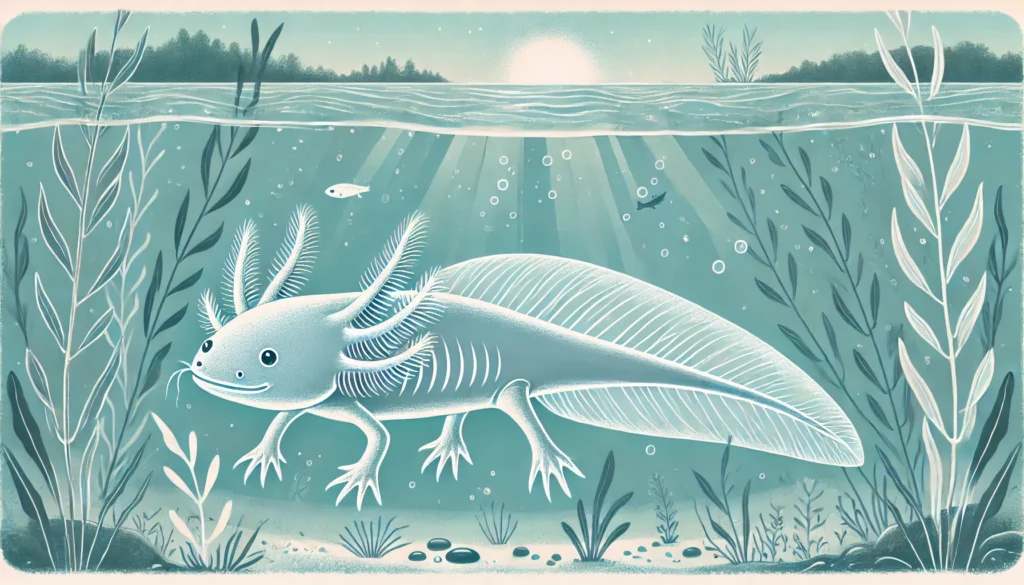The Axolotl (Ambystoma mexicanum) is one of the most unique and intriguing creatures in the animal kingdom. Known for its permanent “smile”, frilly external gills, and extraordinary ability to regenerate body parts, the Axolotl has captured the interest of scientists and animal lovers alike. Native to the lakes of Mexico, this aquatic salamander is sometimes referred to as the “Mexican walking fish”, although it is not a fish at all but an amphibian.
In this article, we will dive into the world of the Axolotl, exploring its physical characteristics, unique regenerative abilities, habitat, diet, and why this smiling creature is so popular.
What is an Axolotl?
The Axolotl is an aquatic salamander that belongs to the Ambystomatidae family, which includes other mole salamanders. However, what makes the Axolotl so extraordinary is that, unlike most salamanders, it retains its juvenile features throughout its entire life. This condition, called neoteny, means that the Axolotl does not undergo metamorphosis like other amphibians and remains fully aquatic.
1. Appearance
Axolotls are instantly recognizable by their distinctive physical features, including their wide, “smiling” mouths, feathery gills, and lizard-like bodies. They typically have a soft, smooth body with a long tail, short limbs, and webbed feet. Their most striking feature is the set of external gills—frilly, branch-like structures that extend from both sides of their head, giving them an almost otherworldly appearance.
Axolotls come in a variety of colors, including:
- Wild Type: Dark brown or greenish with a speckled pattern, which helps them blend into their natural environment.
- Leucistic: Pale pink with visible red gills and black eyes, often mistaken for albino.
- Albino: Pure white or golden with red or pink gills, but with no pigment in their eyes.
- Melanoid: All black with no iridescence or light pigment.
Most Axolotls grow to about 9 to 12 inches (23 to 30 cm) in length, though some individuals can grow even larger.
2. Why Do They “Smile”?
One of the reasons Axolotls are so beloved is because of their seemingly permanent smile. This “smile” is simply the natural shape of their wide mouths, but it has endeared them to people around the world, earning them the nickname “smiling salamander.”
Habitat: Where Do Axolotls Live?
Axolotls are native to Mexico, specifically to two lakes: Lake Xochimilco and Lake Chalco. However, due to urbanization and environmental changes, only Lake Xochimilco remains, and even it has been severely reduced in size and quality. Today, the Axolotl is considered critically endangered in the wild, though it is widely bred in captivity for research and as pets.
1. Aquatic Life
Axolotls are fully aquatic animals, which means they spend their entire lives in water. Unlike many amphibians that go through metamorphosis and move to land, Axolotls remain in their larval stage for life, breathing through their external gills and swimming with their long tails.
Their natural habitat in the wild includes slow-moving waters, dense aquatic vegetation, and plenty of places to hide. In captivity, Axolotls thrive in similar conditions, requiring cool, clean water and plenty of space to swim.
2. Endangered in the Wild
Due to habitat destruction, pollution, and the introduction of invasive species like tilapia and carp, the wild Axolotl population has declined dramatically. Conservation efforts are ongoing to protect the remaining wild Axolotls, particularly in Lake Xochimilco, which has become a key conservation site.
Diet: What Do Axolotls Eat?
Axolotls are carnivorous and have a diet that consists mainly of small prey. In the wild, they are opportunistic feeders, consuming anything that fits into their mouths, including:
- Insects
- Worms
- Small fish
- Crustaceans
- Aquatic invertebrates
Axolotls are also known to eat small amphibians, including other salamander larvae.
1. Feeding in Captivity
In captivity, Axolotls are typically fed a diet of bloodworms, earthworms, pellets, and sometimes small feeder fish. It’s important to provide them with a balanced diet that replicates their natural feeding habits to ensure proper growth and health. Axolotls have poor eyesight, so they rely on their sense of smell and the movement of prey to find food.
2. Suction Feeding
Axolotls are suction feeders, meaning they open their mouths quickly to create a vacuum that sucks prey into their mouths. This feeding method is highly effective for catching small, fast-moving prey in the water.
Regeneration: Axolotl’s Superpower
One of the most amazing features of the Axolotl is its ability to regenerate body parts. While many animals, including some reptiles, can regenerate parts of their bodies, the Axolotl takes this ability to an entirely new level.
1. What Can They Regenerate?
Axolotls can regenerate a wide variety of body parts, including:
- Limbs: If an Axolotl loses a leg, it can regrow the entire limb, including bones, muscles, and nerves.
- Tail: They can regrow a lost or damaged tail.
- Gills: The external gills, which are essential for breathing, can also regenerate if injured.
- Spinal Cord and Heart: Incredibly, Axolotls can even regenerate parts of their spinal cord, heart tissue, and brain.
This remarkable ability has made the Axolotl a subject of intense scientific research. Scientists hope that by studying the regenerative processes of the Axolotl, they may unlock potential medical applications for humans, such as improved wound healing and even tissue regeneration.
2. Why Can They Regenerate?
The exact mechanisms behind the Axolotl’s regenerative abilities are still being studied, but it is believed that their stem cells play a key role. These cells can differentiate into various types of tissue, allowing the Axolotl to replace damaged or lost parts with fully functioning new ones.
Axolotl in Captivity: Popular Pet and Research Subject
Thanks to their unique appearance, calm demeanor, and fascinating biology, Axolotls have become popular both as pets and as research subjects in laboratories around the world. However, keeping an Axolotl as a pet requires special care, particularly in terms of water quality and temperature.
1. Axolotls as Pets
Axolotls are popular in the pet trade due to their unique appearance and relatively simple care requirements. They are generally low-maintenance, but they do have specific needs:
- Water Quality: Axolotls are highly sensitive to poor water conditions, so regular cleaning and water changes are essential.
- Cool Temperatures: Axolotls thrive in cool water temperatures ranging from 60°F to 64°F (16°C to 18°C). Higher temperatures can stress them and lead to health problems.
- Spacious Tank: A large tank with plenty of room to swim and hide is important for their well-being. Decorations such as plants, rocks, and caves can provide hiding spots and mimic their natural environment.
2. Scientific Research
Axolotls are also widely used in scientific research, particularly in the study of regeneration and developmental biology. Their ability to regenerate entire limbs and organs makes them a valuable model for understanding how tissues regenerate and how these processes might be applied to human medicine.
Fascinating Facts About Axolotls
- Neotenic: Axolotls are neotenic, meaning they retain their juvenile features throughout their entire lives. Unlike most amphibians, they do not undergo metamorphosis and remain fully aquatic.
- Regeneration: Axolotls are one of the few animals capable of regenerating entire limbs, parts of their heart, spinal cord, and even their brain. This has made them a major focus of scientific research.
- Critically Endangered: While Axolotls are popular in captivity, they are critically endangered in the wild due to habitat destruction, pollution, and the introduction of invasive species.
- Smiling Salamander: The Axolotl is often called the “smiling salamander” because of the wide, permanent smile created by the shape of its mouth.
- Carnivorous: Axolotls are carnivorous, feeding on small fish, worms, and other aquatic creatures. In captivity, they can be fed a diet of bloodworms, earthworms, and special pellets.
Conclusion
The Axolotl is a truly unique creature that has fascinated scientists and pet owners alike for its smiling appearance, incredible regenerative abilities, and unusual life cycle. Despite being critically endangered in the wild, Axolotls continue to thrive in captivity, where they play a crucial role in scientific research. Whether you’re captivated by its charm or intrigued by its biological capabilities, the Axolotl remains one of the most extraordinary animals in the world.
FAQs
Can Axolotls regenerate body parts?
Yes, Axolotls have the remarkable ability to regenerate body parts, including limbs, tails, spinal cords, and even parts of their heart and brain.
Why do Axolotls always look like they are smiling?
The Axolotl’s wide, upturned mouth gives it the appearance of a constant smile, which is one of the reasons they are so popular as pets.
How long do Axolotls live?
In captivity, Axolotls can live for 10 to 15 years with proper care, including clean water and a balanced diet.
Are Axolotls endangered?
Yes, Axolotls are critically endangered in the wild due to habitat destruction, pollution, and invasive species, although they are common in captivity.
What do Axolotls eat?
Axolotls are carnivorous and primarily eat worms, insects, small fish, and other aquatic invertebrates. In captivity, they are often fed bloodworms, earthworms, and specialized pellets.


